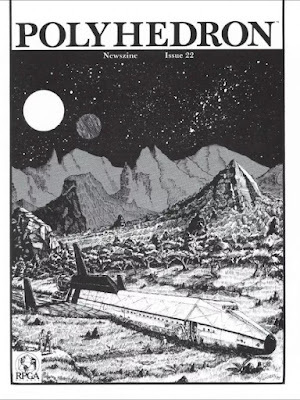Polyhedron: Issue #22
 Issue #22 of Polyhedron (March 1985) features an interesting piece of artwork by Joseph Pillsbury. I say "interesting" not solely for the subject matter of the piece – a downed spacecraft – but because Pillsbury is an artist I mostly remember for his humorous comics in the "Dragon Mirth" section of Dragon. I can't recall his having done any "serious" artwork before, but it's always possible I've overlooked his wider contributions to the hobby.
Issue #22 of Polyhedron (March 1985) features an interesting piece of artwork by Joseph Pillsbury. I say "interesting" not solely for the subject matter of the piece – a downed spacecraft – but because Pillsbury is an artist I mostly remember for his humorous comics in the "Dragon Mirth" section of Dragon. I can't recall his having done any "serious" artwork before, but it's always possible I've overlooked his wider contributions to the hobby.Penny Petticord's "News from HQ" has two items worthy of note. The first is an announcement that Polyhedron is actively seeking submissions from readers. Petticord states that "only a few members" have thus far been making submissions and she'd like to change that. I wish I'd paid more attention to this at the time, because I made several submissions to Dragon while I was in high school and all were rejected. I might have had a better shot with Polyhedron, given the dearth of submissions. Secondly, Petticord warns readers that the next issue will a "special April Fool" issue, so "don't believe anything you read" in its pages. Fair enough!
This issue also features a large letters page, with multiple letters written in response to Roger E. Moore's "Women in Role Playing" essay from issue #20, While not all of the letters were critical, many of them were, largely because the readers felt that Moore had "belittled" or otherwise failed to understand female gamers. Though Moore apologizes for any unintended offense, he nevertheless stands by what he wrote, noting that it's an important topic in need of more frank discussion. Some things never change, I guess.
Gary Gygax returns to this issue, writing yet again about marlgoyles and their reproduction. He provides AD&D stats for every stage of the creature's growth from hatchling to mature. It's baffling to me, but it's definitely in keeping the naturalism that's a hallmark of his worldbuilding. He also provides stats for a "monster" that was somehow left out of Monster Manual II – amazons. Amazons, in Gygax's vision, are a female-dominated society of barbarians, with menfolk in secondary or support roles. Beyond that, he doesn't have much more to say about them, which I found a little disappointing, because they're a great fantasy concept worthy of inclusion in D&D.
Frank Mentzer's "Spelling Bee" focuses on druid spells and abilities. Interestingly, Mentzer concern this time seems more focused on reining in druid abilities (like shapechange) that he thinks can be easily abused rather than on finding new and creative ways to make use of them. "The RPGA Network Tournament Ranking System" article is not especially interesting in itself, at least to me. However, the accompanying ranked list of RPGA judges and players is. Gary Gygax, for example, is the only Level 10 Judge, just as Frank Mentzer is the only Level 9. There are no Level 8 or 7 Judges and only one Level 6 (Bob Blake). The names on both lists include quite a number of people who either were at the time or would later be associated with TSR or the wider RPG world. It's a fascinating window on a particular time in both the hobby and the industry.
"In the Black Hours" is an AD&D adventure for levels 6–9 by David Cook. The scenario is unusual in a couple of ways, starting with its lengthy backstory about a high-level mage who learned the true name of the demon lord Juiblex and, in order to protect himself, was eventually forced to imprison the demon with a magical crown. That crown has now come into the possession of a merchant who wishes to protect it from would-be thieves (employed by Juiblex's demonic underlings who wish to free him). The characters are hired by the crown's present owner to protect it over the course of the night when he believes the thieves will make their attempt. There's a lot going on here and the basic structure of the adventure – mounting a defense against waves of attackers – seems well suited to a tournament set-up. If anyone ever played this scenario (or one like it), I'd be very curious to hear how it went.
"Away with Words" by Frank Mentzer is a 26-word multiple choice quiz that challenges the reader's knowledge of High Gygaxian words. It's a fun enough little diversion, though less hard now, thanks to the ubiquity of online dictionaries. "Unofficial New Spells for Clerics" by Jon Pickens does exactly what it says: offers a dozen new spells for use by clerics. Most of these spells are connected in some way to existing magic items, like the staff of striking or necklace of adaptation, filling in gaps in the spell list that, logically, should exist. While that certainly makes sense, it's also boring and exactly the kind of magic-as-technology approach that I've come to feel kills any sense of wonder in a fantasy setting.
"Dispel Confusion" continues to narrow its scope. This issue we're treated only to questions pertaining to D&D, AD&D, and Star Frontiers. Most of them are the usual collection of nitpicks and niggling details. However, one stood out as noteworthy (and indeed unexpected):
 I have to admit that this answer surprised me – not because I didn't already know what it would say, but because I didn't imagine I'd ever read such a thing in a TSR periodical. In the past, these magazines tended to advance a very strong "by the book" line when it came to the rules, as evidenced by the fact that there's an official column for questions and answers. I can't help but wonder if perhaps this represented a change in thinking during the final years of Gygax's time at the company (he'd leave for good October 1986 – about a year and a half into the future).
I have to admit that this answer surprised me – not because I didn't already know what it would say, but because I didn't imagine I'd ever read such a thing in a TSR periodical. In the past, these magazines tended to advance a very strong "by the book" line when it came to the rules, as evidenced by the fact that there's an official column for questions and answers. I can't help but wonder if perhaps this represented a change in thinking during the final years of Gygax's time at the company (he'd leave for good October 1986 – about a year and a half into the future)."Of Great Ships and Captains" by Roger E. Moore is the second part of his "big ships" article for Star Frontiers. Unlike part one from the previous issue, this second part focuses on the fine details of running a campaign aboard a large starship. Moore takes a look at deckplans, crew complement, shipboard positions, and the kinds of adversaries and adventures that work in such a campaign. It's all very good stuff and, as I mentioned in my write-up of issue #21, I found it very inspirational in my younger days. The only real criticism I can muster about the article is that it does not include a set of sample deckplans for a big ship, as promised. Production delays apparently prevented their inclusion and, while Moore states they would appear in a future issue of Polyhedron, I don't believe they ever did. If I'm mistaken about this, I'd love to know.
The issue concludes with the return of "The Treasure Chest," the RPGA catalog of exclusive items that has not been seen in quite some time. The items available for sale are now mostly RPGA tournament modules that were otherwise unavailable at the time, along with some exclusive miniatures and back issues of Polyhedron. I wonder what occasioned the return of the catalog, since I can't imagine that it made enough money for that to have been a serious consideration. In any case, we're inching ever closer toward the end of my time as a subscriber to the newszine, meaning this series will likely conclude before we reach the summer months.
James Maliszewski's Blog
- James Maliszewski's profile
- 3 followers



